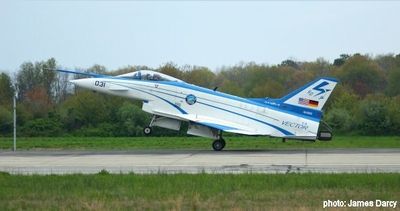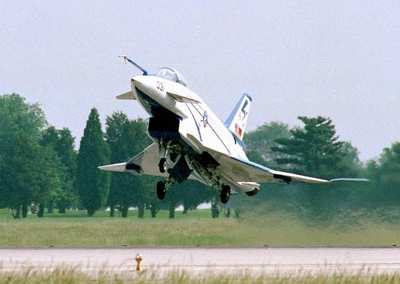Vectored-Thrust Landing Was 'Hands-Off'
The VECTOR test team completed the world's first fully
automated, thrust vectored landing at Patuxent River (MD) on April
22, and plans subsequent landings this week at increasing angles of
attack and decreasing speeds. At about 2:30 p.m. in the afternoon
last Tuesday, German Naval Reserve Cmdr. Ruediger Knoepfel flew the
X-31 into an invisible engagement box in the sky, then watched as
the aircraft controlled itself to touchdown before he took over
control and lifted off again.

"Today we saw what we have worked three years for," Knoepfel
said. "We have proved the basic functionality of our system."
Since the X-31's arrival at 'Pax River' in April 2000, the
VECTOR test team has been exploring the mechanics of automated,
thrust vectored, extremely short takeoff and landing, with the
focus on landing as the more difficult portion of ESTOL.
The X-31 uses thrust vectoring -- controlling the direction of
its engine exhaust with paddle-like vanes -- to maintain control at
high angles of attack and reduced speeds, even well below the
typical landing speed for an aircraft of its type.
Thrust vectoring was engaged for last week's ESTOL touch-and-go,
said Navy deputy program manager Bill Voorhees, but for the first
attempt the angle of attack was limited to 12 degrees, which is the
aircraft's normal landing attitude. Future attempts will increase
the angle of attack one degree at a time, up to a maximum of 24
degrees before the program's conclusion on April 29. (At 24 degrees
angle of attack, landing speeds are reduced 30 percent.)
The automated ESTOL landing maneuver has already been
demonstrated at altitude, with Knoepfel and fellow project test
pilot Marine Corps Maj. Cody Allee having flown approaches in past
months up to 28 degrees angle of attack to a "virtual runway" at
5,000 feet.
How can they do that?
The ESTOL approach is complex relative to a conventional
landing, but is managed by redundant flight control computers,
which actually fly the landing. At higher angles of attack, with
the aircraft's nose pointed well above the horizon, the first part
of the X-31 to touch the ground would be the engine nozzle, not the
landing gear. To prevent a tail strike, the X-31 performs a
derotation maneuver when the tail is just two feet above the
runway, dropping onto its main landing gear.
The X-31 derives its location relative to the runway from an
Integrity Beacon Landing System, which uses differential global
positioning system data combined with links to beacons on the
ground to pinpoint the aircraft's position in space. The system is
accurate to within a couple centimeters, said Doug Wilkin, lead
flight test engineer.
"Everything worked perfectly and was just as we had done it in
the simulator," Knoepfel said of the successful flight. "There was
a very smooth flare and touchdown. I must admit that it was a
smoother landing than I can sometimes do."
"That was the highlight in my flying career," he added, walking
back to his office after the flight. That is no small boast from
Knoepfel, who was selected as Germany's chief test pilot this
year.

'I can't see.'
The X-31 flies a steeper glide slope for the ESTOL approaches
than for a conventional landing, providing "a view that we have to
get accustomed to," said Knoepfel. At higher angles of attack, the
view will get even more interesting; above 15 degrees, the pilot
loses sight of the runway and must rely on a video camera in the
belly of the aircraft to verify the runway is free of
obstructions.
Despite the potential for white knuckles, Knoepfel said "there
wasn't time to be nervous." When he touched down, he realized the
dream of more than 50 test team members waiting on the ground, who
have been working together for three years to get to that moment.
The VECTOR project has been a partnership between the Navy,
Germany's Federal Office of Defense Technology and Procurement,
European Aeronautic Defence and Space Company and Boeing
Aerospace.
"This was really a team success," Knoepfel said. "I was just the
man in the cockpit."
 For
the Navy, demonstrating the feasibility of thrust-vectored ESTOL
landings could give planners an important set of options as they
shape acquisition decisions over the coming decades, program
officials believe. In the fleet, landings at reduced speeds and
subsequently higher angles of attack would impart significantly
reduced forces to both the aircraft and, in the case of carrier
landings, the arresting gear on the ship, said VECTOR program
manager Jennifer Young.
For
the Navy, demonstrating the feasibility of thrust-vectored ESTOL
landings could give planners an important set of options as they
shape acquisition decisions over the coming decades, program
officials believe. In the fleet, landings at reduced speeds and
subsequently higher angles of attack would impart significantly
reduced forces to both the aircraft and, in the case of carrier
landings, the arresting gear on the ship, said VECTOR program
manager Jennifer Young.
In the short term, however, the VECTOR remains a research
project based around the only manned X-plane currently in flight.
The X-31 is in that sense a "true" X-plane, being solely a tool to
explore concepts and technologies. "Our main product," Young said,
"is knowledge."
[Thanks to James Darcy, NAS Patuxent River Public Affairs
--ed.]
 ANN's Daily Aero-Linx (04.13.24)
ANN's Daily Aero-Linx (04.13.24) ANN's Daily Aero-Term (04.13.24): Beyond Visual Line Of Sight (BVLOS)
ANN's Daily Aero-Term (04.13.24): Beyond Visual Line Of Sight (BVLOS) Airborne 04.09.24: SnF24!, Piper-DeltaHawk!, Fisher Update, Junkers
Airborne 04.09.24: SnF24!, Piper-DeltaHawk!, Fisher Update, Junkers Aero-News: Quote of the Day (04.14.24)
Aero-News: Quote of the Day (04.14.24) ANN's Daily Aero-Term (04.14.24): Maximum Authorized Altitude
ANN's Daily Aero-Term (04.14.24): Maximum Authorized Altitude





